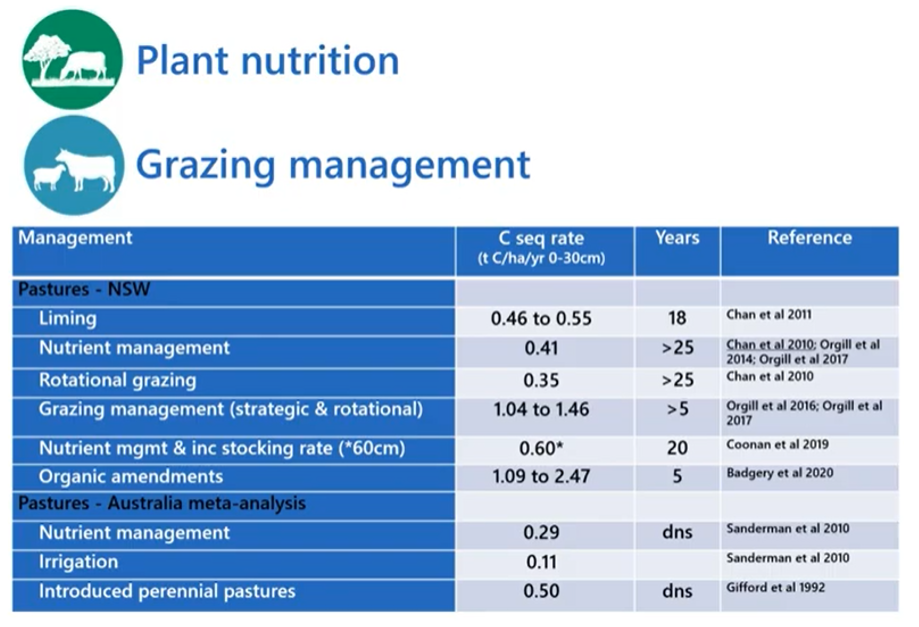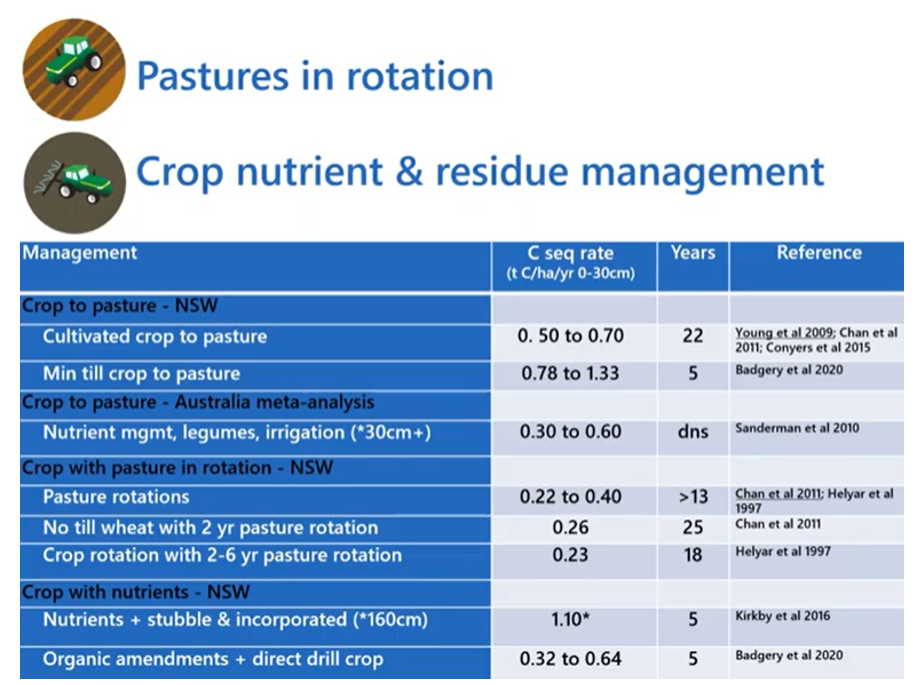How to get a soil carbon project started
30 Aug 2021
By Regional Agricultural Landcare Facilitator, Rohan Leach
There is a growing interest among primary producers to capitalise on the benefits of soil carbon (C). Whether you are broadacre cropping, horticulture or managing livestock, increasing soil carbon levels also increases your soil’s productivity. Increasing soil organic carbon is directly correlated to increased soil cation exchange capacity, soil fertility and soil water holding capacity. If you’d like to learn more about these co-benefits please watch our Soil Carbon for Your Farm Business webinar series found here.
In addition to the obvious benefits that soil carbon provides to your soil health, it could also offer direct benefits to your bottom line through a soil carbon project.
What does a soil carbon project involve?
A soil carbon project stores C in agricultural soil to reduce the level of greenhouse gases in the atmosphere. The Emissions Reduction Fund (now rebranded to the Climate Solutions Fund), which is overseen by the Clean Energy Regulator (CER), provides the main pathway for landholders to earn income from soil carbon projects. Carbon offsets are generated by a project in the form of Australian Carbon Credit Units (ACCUs), with one ACCU representing one tonne of carbon dioxide equivalent. Landholders may then choose to sell their ACCUs on the open or spot market or contract them to the government.
There are currently two main types or “methods” of soil carbon projects; ‘Measurement of soil carbon sequestration in agricultural systems’ and ‘Estimating sequestration of carbon in soils using default values’ (model-based soil carbon). The measurement method requires thorough measurement and soil analysis upfront, to a depth of 30cm. The model based approach offers a lower cost alternative to the sampling and measurement method, however this method is much more conservative with the amounts of C sequestered.
The major requirements for you to consider for a new soil carbon project are:
- Grazing or cropping systems (including perennial woody horticulture) are the key enterprise types to support soil C projects under the current method
- You must be willing to undertake new land management activities
- The soil C generated must be measured
- Projects are long term in nature. You must be willing to store C for at least 25 years after the first ACCUs are issued.
A new method is currently being developed in 2021 which is a hybrid combination of the two methods mentioned previously. It combines both modelling and measurement in an effort to make the process easier and cheaper as it could reduce sampling for projects up to 90%. This draft for this method is currently seeking public consultation – read more about it and have your say here.
What sort of projects are eligible?
The main question to consider with a potential soil carbon project is: “Are you going to undertake a new land management strategy on your project area?” There needs to be a change in the farming status quo. The situation ideally is suited to the purchase of new land which may have been run down or a change in management (i.e. succession), however there is plenty of potential instances where producers can have a go at a soil project, such as land use rotation.
Different practises suited for measured soil carbon projects include:
- Applying nutrients, lime or gypsum to improve soil health
- Installing irrigation.
- Re-establishing or rejuvenating a pasture by seeding.
- Establishing pasture where there was previously no pasture (converting cropland to pasture)
- Altering stocking rate, duration or intensity of grazing.
- Retaining stubble after crop is harvested.
- Converting from intensive tilling to reduced or no-tilling practices.
- Modifying landscape features to remediate soils e.g. water ponding or deep ripping
- Using mechanical means to add or redistribute soil through the soil profile.
You will notice that a lot of these activities share a similar theme; that is to increase the soils productivity. The application of lime and nutrients to treat soil constraints, implementation of rotational grazing to promote plant growth, stubble retention when compared to continual cultivation are all management techniques, we know improve productivity and biomass growth as a result. When it comes down to it, increasing soil carbon is all about increasing plant growth; more plant biomass equals more soil carbon!
What if I’ve already been doing these practices for years?
It is only new management changes that you plan on undertaking that will count toward your accumulated carbon levels. If you have been managing your land for the past 20 years in a way that has increased soil carbon, such as converting from cultivated cropping country to perennial pastures, unfortunately this increase cannot be counted retroactively in future soil carbon measurements. There must be change to the status quo for you to generate ACCUs.
What is a project worth?
In a recent review of 126 grassland studies from around the world, conversion from cropland to permanent pasture led to an average increase of soil carbon across all 126 studies of 0.47 t C/ha/year (Conant et al., 2017). In much of Australia, sustained sequestration rates of greater than 1 t C/ha/year are difficult to achieve due to rainfall levels which limit plant growth (White et al., 2021). This is supported by Badgery et al., 2020 with work at Cowra that found changes in soil carbon after a change from cropping to pasture averaged at 0.97 t C/ha/year.
This is much lower than some in the industry currently claim, so producers must be wary of overestimating the potential value of their project. Remember projects are over 25 years generally, so big increases may be observed in the first few years of a project, but it is unlikely that these increases will continue for the life of the project. See Figure 1 and 2 for some examples of management practises and their C sequestration rates over a number of years.
CSIRO has developed a handy tool called LOOC-C which is designed for landowners to quickly assess their carbon project options. Using satellite and modelling technology it can estimate your current soil carbon levels and give an estimate of the likely increase in soil carbon if you undertake certain activities.
Figure 1: Grazing management practises and their corresponding rates of carbon sequestration over time (Source: Soil Carbon for Your Farm Business - The Science of Soil Carbon, CW LLS)
Figure 2: Cropping management practises and their corresponding rates of carbon sequestration over time (Source: Soil Carbon for Your Farm Business - The Science of Soil Carbon, CW LLS)
Currently, ACCUs are worth about $16 each if contracted to the Australian government or around $23 on the spot market (as of 8/9/21). Note that a tonne of soil carbon is worth 3.67 tonne of CO2 (just think, soil is heavier than gas), so the values mentioned above are multiplied. For example if we take this global average of 0.47 t C/ha/year and multiply it by 3.67, this would mean we generate around 1.72 ACCUs /ha/year. This, in dollar terms is around $27.60/ha/year. With the project life of 25 years, the amount of ACCUs generated could be worth around $700/ha over the length of the project.
The costs associated with a measured carbon project can be quite high and in some cases, prohibitive. Soil sampling, testing and independent auditing are all required for a project and can run into the tens of thousands of dollars, depending on the project size. Typically, this could vary from $30-100/ha. Alternatively, engaging the services of a consultant can take much of the upfront costs out of a project as well as many of the hassles. As payment, consultants or ‘aggregators’ often take a percentage of the ACCUs accumulated in a project ranging from 18-44% (White et al., 2021).
Conclusion
When we look at the costs to implement a soil carbon project and the long term nature of the project with fairly low returns, it is no wonder few projects have been registered. However, the opportunity is there for producers that are already planning on adopting these changes voluntarily to their business. If you are transitioning away from continuous cropping into a more perennial pasture system or pasture in a rotation with your cropping, planning on adding soil ameliorants to treat soil constraints or planning on increasing your soils productivity – than a soil carbon project may suit you.
Visit the Clean Energy Regulator’s website to learn more about setting up a soil carbon project. If you’d like to know more about consultants in the carbon industry visit the Carbon Market Institute’s website.
The carbon market can be a tricky place with a vast amount of information to navigate. Please consider engaging a consultant if you would like further information or contact your local member of the LLS Ag Advisory team.
Bibliography and further resources
White R.E., Davidson B and Eckard R. (2021) ‘An everyman’s guide for a landholder to participate in soil carbon farming in Australia’. Australian Farm Institute, Occasional Paper No.21.01, August 2021.
Badgery W., Murphy B., Cowie A., Orgill S., Rawson A., Simmons A. and Crean J. (2020) ‘Soil carbon market-based instrument pilot – the sequestration of soil organic carbon for the purpose of obtaining carbon credits’. Soil Reseacrh 59, pp. 12-23.
Conant R.T., Cerri C.E.P., Osborne B.B. and Paustian K. (2017) ‘Grassland management impacts on soil carbon stocks: a new systhesis’. Ecological Applications 27(2), pp. 662-668.
Emissions Reductions Fund – case study videos on YouTube

